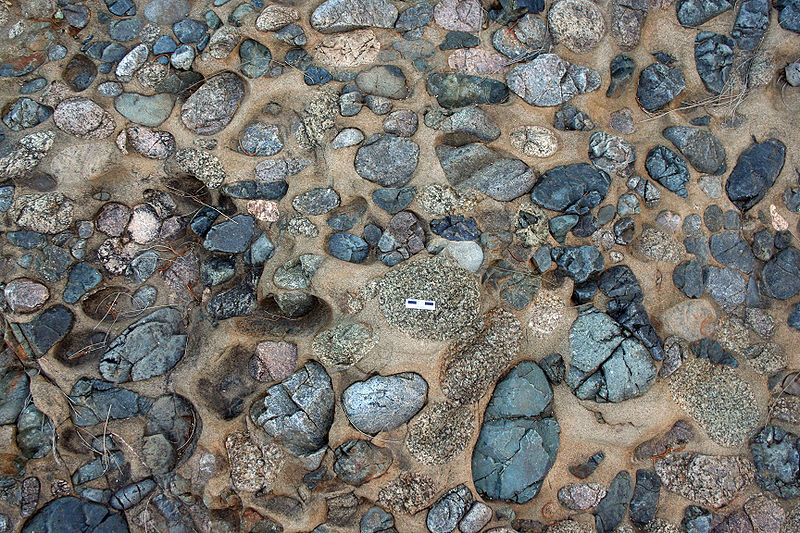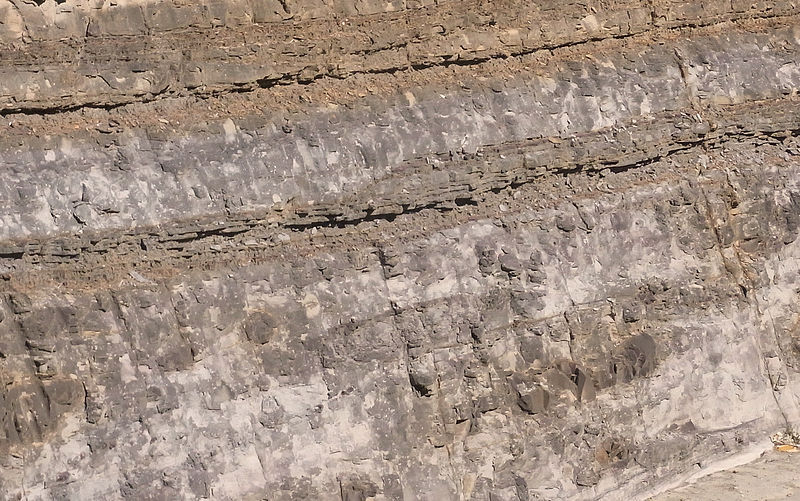A rock is a solid material that makes up the Earth's crust. It consists of an assembly of minerals.
Rocks present several aspects and various compositions. In order to simplify their classification, scientists have classified them into three broad types based on their formation processes. These rocks, while stable in appearance, can transform and change categories over a very long period of time.
It is important to differentiate a rock from a mineral. A mineral is a natural element or a chemical compound that forms soils and rocks. A rock is therefore composed of one or more minerals.
The rock cycle illustrates the origin of the three major types of rock. Magma, coming from the internal mantle of the Earth, is responsible for the formation of the Earth's crust. Magma is therefore the starting point of the rock cycle. It is also the point of arrival since all the rocks will end up, after several tens of thousands of years, melting again into magma.
During the cycle, the magma circulating beneath the Earth's crust cools (4) and then forms igneous rocks (or magmatic rocks). These igneous rocks, exposed to environmental agents, break down into small particles that will be carried by wind, water, and other erosion agents (1). The accumulation of these particles will cause the formation of sedimentary rocks. Igneous and sedimentary rocks, under the effect of elevated temperatures or high pressures (3) generated by the movements of the Earth's crust, are liable to transform into metamorphic rocks. It is worth noting that metamorphic rocks can also undergo erosion (1) and produce the particles that underlie sedimentary rocks. Finally, all the rocks, when buried near magma, melt and return to magma (2). The cycle is then complete and can restart.

Summary of the rock cycle
Igneous rocks are rocks that result from the cooling and crystallization of magma.
Igneous rocks are the most common rocks in the Earth's crust. The word “igneous” comes from the Latin word igneus which means “comes from fire." Thus, magma, a viscous liquid formed from molten rocks and containing gases dissolved at very high temperature, is the source of igneous rocks. The magma is carried to the Earth’s surface where it will be cooled and then solidified. The crystals form in a disorderly manner, without any particular orientation. The rocks resulting from this process are said to be igneous.
Depending on whether the cooling takes place outside or inside the Earth's crust, two types of igneous rocks can be distinguished: intrusive igneous rocks and extrusive igneous rocks.
When the magma cools slowly and completely inside the Earth, it is referred to as intrusive igneous rocks, also called plutonic igneous rocks. Slow solidification of the magma will give rise to rocks with crystals that are easily visible to the naked eye (large crystals).
Examples of intrusive igneous rocks
|
Granite |
Granite is made up of minerals visible to the naked eye. There are 500 different varieties of granite. The predominance of a mineral in its formation will have an impact on the colour of the granite. Most types of granites are formed from the following minerals: quartz, biotite, orthose, hornblende, magnetite, garnet, zircon, and apatite. |
|
Diorite |
Diorite also has crystals visible to the naked eye, but there are fewer colour varieties in its specimens than in granite. Diorite is mainly formed from the following minerals: plagioclase, hornblende, and sometimes even biotite. |
|
Gabbro |
Gabbro has four varieties of specimens ranging from predominantly green to black. Since it is an intrusive igneous rock, the minerals that make up gabbro have had time to crystallize thoroughly. Gabbro crystals are therefore clearly visible to the naked eye. Its mineral composition comprises plagioclase, pyroxene, olivine, and biotite. |
Volcanic eruptions are manifestations of a spectacular and very rapid rise of magma from the Earth’s depths. The magma then cools very quickly and the resulting rocks have a fine texture, free from crystals visible to the naked eye. These rocks are said to be extrusive igneous rocks.
Occasionally, small holes can be observed in some extrusive igneous rocks, such as pumice stone. These small holes were formed by the rapid degassing of the lava projected during the volcanic eruption, thus forming bubbles.
Examples of extrusive igneous rocks
|
Pumice stone |
Pumice stone is special due to the presence of small holes (pores) throughout its structure. This rock is highly valued for its abrasive qualities. |
|
Obsidian |
Obsidian has a glassy appearance. It is grey, green, black, and sometimes even red. The lava from which it was formed cooled so quickly that no crystallization had time to occur (or almost). Obsidian is formed as a result of volcanic eruptions, especially underwater. |
|
Basalt |
The oceanic crust consists primarily of basalt, a dark extrusive igneous rock made up of plagioclase, pyroxene, olivine, and magnetite. |
Sedimentary rocks are rocks formed by the gradual accumulation of sediments.
As the name suggests, Sedimentary rocks are formed by sediments, which are rock fragments (igneous or metamorphic) formed by erosion and are carried away. Sedimentary rocks often form in stratigraphic layers, which tells us about the history of the Earth. These rocks sometimes contain fossils.
According to their formation process, two types of sedimentary rocks are distinguished: detrital sedimentary rocks and chemical sedimentary rocks.
This type of sedimentary rock is formed from sediments accumulated in layers or strata. This type of formation is common in water where suspended sediments are eroded, carried away, compacted, and cemented: shells, rock fragments (igneous or metamorphic), or animal fragments (shells, bones, etc.), sand, clay , etc.
Examples of detrital sedimentary rocks

Sandstone
These rocks are also formed by the accumulation of sediment. However, the sediment that accumulates comes from the precipitation of substances found in water. These sediments of chemical origin come mainly from the evaporation of seawater, rich in mineral salts.
Examples of chemical sedimentary rocks

Limestone

Dolomite
Metamorphic rocks are rocks that have undergone a “metamorphosis,” a transformation, due to heat or pressure in the Earth's crust.
Under high temperature and pressure, igneous rocks and sedimentary rocks can transform into metamorphic rocks. When the temperature is hot enough to allow recrystallization, new crystals form. The rearrangement can also lead to the formation of uniform bands of crystals in the rock.
There are two types of metamorphic rocks depending on the process involved: regional metamorphism modifies the rocks in place due to the pressure between two tectonic plates (these rocks are sometimes said to have a banded structure), whereas contact metamorphism involves the heat released by the magma in the Earth's crust (these rocks will not have a banded structure).
|
Types of metamorphic rocks |
Characteristics |
Examples |
|
Regional metamorphism (caused by large-scale pressure) |
These rocks are formed at high temperatures and pressures. Recrystallization and rearrangement of minerals contained in pre-existing rocks in the affected area then occur. |
Schist
Gneiss |
|
Contact metamorphism |
Sometimes recrystallization occurs without any mineral rearrangement. This results in the formation of metamorphic rocks that do not have a foliated or banded structure. |
Marble |
Petrography is the science that identifies and classifies rocks.
To correctly identify a rock, the main characteristics that distinguish igneous rocks, sedimentary rocks, and metamorphic rocks must be known. The categories of the same type of rock must also be differentiated. For instance, being able to recognize the differences between an intrusive igneous rock and an extrusive igneous rock is essential.
Once the type of rock (igneous, sedimentary, or metamorphic) and its category have been determined, simply consult directories with photos to find the exact name of the specimen.
It can then be useful to create a table with the main characteristics of the specimen to be identified (type, category, dominant colour, other colours, etc.) and to attach a photo.










